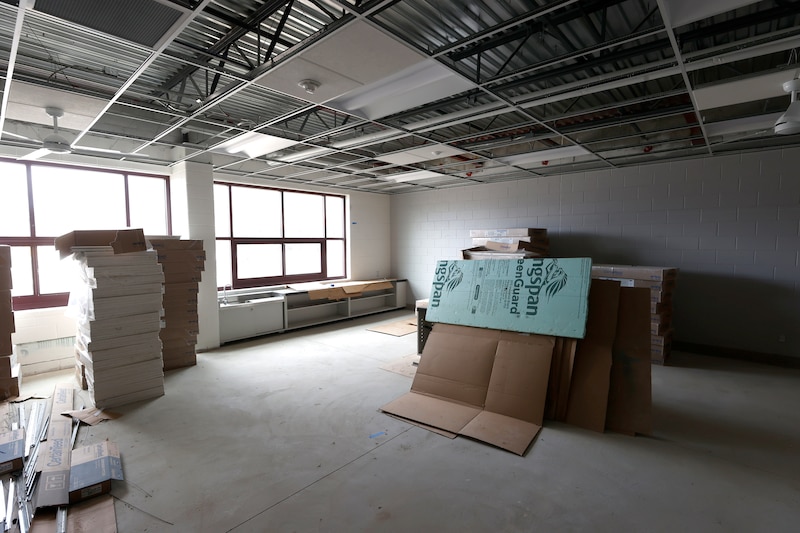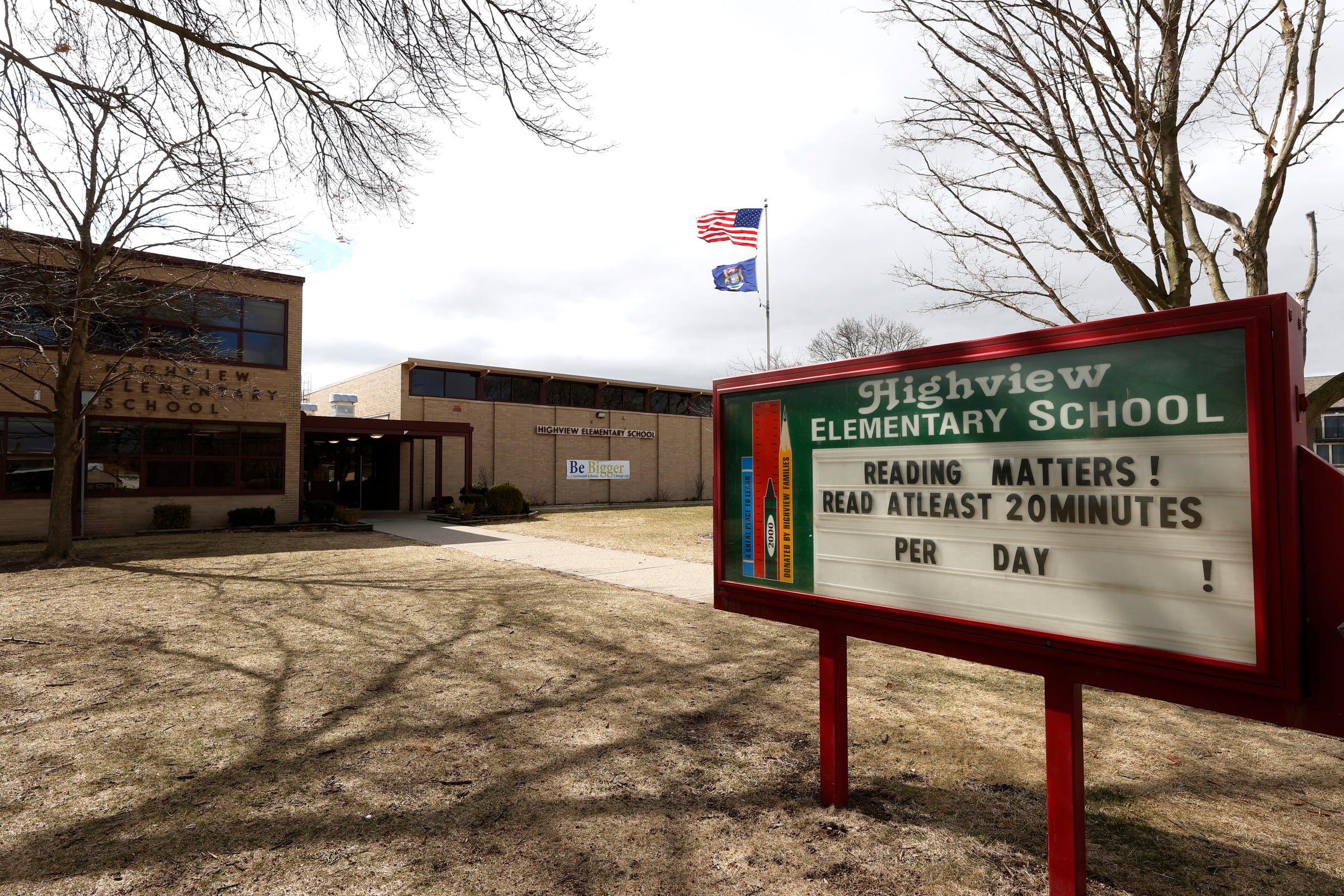As many as 32 students crowd into classrooms originally meant for 22 to 24 students in the Crestwood School District.
Many of Crestwood’s buildings were built in the 1960s, said Youssef Mosallam, superintendent of the district in Dearborn Heights. But updates have been few and far between for the district’s needs, the superintendent said.
Then came a small fortune from the federal government: $24 million in COVID relief funds for the district of nearly 3,800 students. At least $8 million of the relief money is going to build 12 new classrooms in the district’s elementary schools, to reduce class sizes and to keep students spaced farther apart, he said.
Dozens of school districts across Michigan are also directing relief funds to rehab aging school buildings, some of which lack air conditioning or functioning heating systems. In rural Harrison Community Schools north of Mount Pleasant, Superintendent Judy Walton said that means heat may work in one side of a school building in the morning and the other side in the afternoon. The district hasn’t had the funding to make updates for years, she said.
For school districts in lower-income areas like Harrison, relief funds have covered essential facility upgrades that annual state funding and bond money don’t.
“We’re probably one of the most economically depressed counties in Michigan,” Walton said. “So the availability of those funds to do those HVAC upgrades was really critical for us.”
Michigan’s public schools planned to spend about 18% of relief funds on buildings and facilities needs, according to a May 2022 analysis of approved school district plans by the Citizens Research Council of Michigan, around $641 million at that time. Since the analysis, more spending has likely been approved. In all, Michigan schools have nearly $6 billion in COVID relief funds to spend by September 2024.
The largest district in the state, Detroit Public Schools Community District, is also allocating roughly half of its more than $1 billion in relief funds to building needs, a total not included in the Citizens Research Council’s analysis.
Michigan schools might be particularly hard-pressed to find funding to keep buildings from falling apart. Robert McCann, executive director of the K-12 Alliance of Michigan and part of a group advocating for stronger school funding measures in the state, said Michigan is one of only a few states in the nation that do not specifically allocate money for facilities on a statewide level. The state in its most recent budget created a fund partially dedicated to infrastructure, with $250 million for buildings. Gov. Gretchen Whitmer has also recommended $500 million for the next budget to go to infrastructure.
“Michigan probably has a much more rapidly aging school infrastructure than a lot of other states do,” he said, “because Michigan is also one of the handful of states that doesn’t really have any sort of statewide infrastructure spending for schools.”
Schools close because of building problems
Lawmakers in June 2022 assigned $20 million to go to an audit of school facilities in the state. McCann said such a study has never been conducted before.
But anecdotal evidence suggests many Michigan school buildings in low-income areas are in disrepair or facing major problems:
- Flint Schools closed for several days in summer 2021 due to a lack of air conditioning in certain buildings.
- Dearborn Schools canceled class when temperatures soared in June 2022 because some rooms in the district weren’t cooled.
- A Government Accountability Office report in 2020 found that half of the districts it studied across the nation needed multiple systems, such as the HVAC system, replaced. GAO officials visited a school building in Michigan that still relied on a boiler from the 1920s for heat.
- The photos in the GAO report included one of water damage in a Michigan school library and another of signage warning of asbestos.
- In 2016, a series of protests led by Detroit public schools educators raised, among other issues, crumbling conditions in the district’s school buildings. Teachers described mold issues, leaky ceilings, and pest infestations.
In May 2022, the Detroit Public Schools Community District’s board approved a $700 million facilities plan to address longstanding needs. The plan involves rebuilding five buildings and renovating 64, focusing on roofing, heating and cooling, building exteriors, and lighting.

The district will use nearly half of its COVID relief money to make the sweeping changes over the next five years.
A national analysis of spending data by the Associated Press found that school districts with the highest numbers of students living in poverty are more likely than wealthier districts to spend the relief funds on building and transportation upgrades.
Phyllis Jordan, associate director at FutureEd, an education think tank based at Georgetown University, said it makes sense that districts in low-income areas are directing funds to facilities after struggling for so long.
“It also reflects that a lot of these poor districts, with years and years of disinvestment, of underinvestment — that they haven’t been able to make these repairs,” she said. “This is an opportunity with a lot of cash and a lot of cash they have to spend quickly.”
In Michigan, that means districts like Walton’s are turning to federal relief funds to address critical building issues. Nearly 54% of students in Harrison Community Schools are economically disadvantaged, defined by eligibility in the free or reduced price lunch program.
The Harrison district is spending $3.15 million to install air conditioning where the district doesn’t have it, and to replace old furnaces and air-handling units. Bond money approved by the community in past elections has helped facilities, Walton said, but ultimately, property values in the area weren’t high enough to cover HVAC repairs and replacements.
“You can only get so much through a bond, and at some point, the balance of the percentage of home value isn’t going to support the numbers you need,” she said.
Michigan’s school funding formula does not allocate specific sustained funding for buildings or facilities, which means schools without bond or other supplemental funding often struggle to find room in the budget to replace failing boilers or fix what’s broken. The most recent state budget did allocate some funds, $250 million, for school facilities, though the money hinges on a statewide facilities audit that has not yet been conducted. It’s also unclear whether the fund is ongoing or one-time.
Building improvements pay off later
Essexville-Hampton Public Schools near Bay City will use $1 million in COVID relief funds to help fund a nearly $5 million energy efficiency project in its buildings, Superintendent Justin Ralston said. The district was able to pay for the rest of the project with bond money, but the COVID relief funds helped bring the project to fruition.
More efficient buildings will save money in the long run.
“Everybody is strapped for cash,” Ralston said. So the energy efficiency project “is looking at adding new heating boilers, new rooftop units, chillers, and then also doing water conservation efforts in all of our buildings.”
In Crestwood, Mosallam, the superintendent, said district leaders focused on areas that most needed improvement, finding class sizes and school security to be priority areas. To lower class sizes, Crestwood needed more classrooms. And to ease security concerns, the district needed to add cameras and door lockdown systems, and upgrade fire systems.
While many districts are focusing on necessities, research indicates that higher quality school facilities help students learn. When they feel safe and in a nurturing environment, they’re more likely to engage with education.
Olivia Graf Doyle, design principal for Architecture for Education, a California-based firm dedicated to learning environments, said funding ideal learning environments in public schools has always been difficult, because schools often struggle to receive funding for even the necessities, such as keeping heating and cooling systems running or fixing bona fide safety hazards like crumbling ceilings.
Features like big glass windows or folding walls that seamlessly connect classrooms or enhanced outdoor spaces end up feeling like luxuries, she said.
“We really need to shift the conversation away from physical security and barriers, to really how we can use the learning environment to create a sense of belonging, which inherently builds safety,” she said.
Jordan said a lot of focus in media coverage around this spending has gone to new athletic fields or other projects that may seem more frivolous. But projects like that are rare, she said, according to her organization’s research. Instead, Jordan said districts nationwide are taking care of the necessities.
One school superintendent from a rural area of the country told Jordan that in an effort to replace a school’s roof, an inspection found the entire school needed to be condemned.
“Now there’s a lot of pushback like, ‘This is money that’s supposed to be emergency money or learning loss. Why is it going to facilities?’ And that’s a legitimate point,” she said. “But at the same token, you can’t really divorce facilities from learning. If kids are too hot or too cold, if there’s mold in the building, you get a lot of absenteeism. It’s harder to learn.”
Editor’s note: This story has been edited to add details around the state’s school consolidation and infrastructure fund.
Lily Altavena is an education reporter for the Detroit Free Press. You can reach Lily at laltavena@freepress.com.





